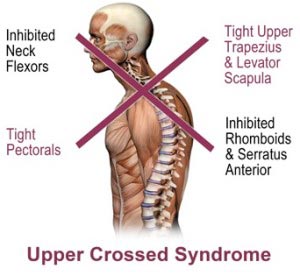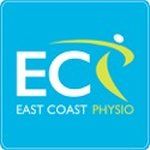Neck pain is becoming increasingly common and causes considerable impact on individuals with an estimated 1 year incidence of neck pain, ranging between 10- 21%, with a higher incidence noted in office and computer workers.
The majority of neck pain is classified as simple mechanical neck pain. The human head weighs on average 8-12 lbs! Therefore, it is not surprising with inadequate postures and the repetitive daily tasks we experience neck pain.
Common neck complaints:
Neck tension
Repetitive poor postures are common in this modern world of office and computer based environments, further added by ipads and iphones when we relax at home! Pain from muscle and joint tension may cause cervicogenic headaches for some, which can be further aggravated by stressful environments. A common complaint is forward head posture or also known as ‘Upper crossed syndrome (Figure 1)’. Commonly treatment is required to reduce tension and activating the inhibited muscle groups, which is part of your management at East Coast Physio.
Cervical spondylosis
Degenerative (osteoarthritis) changes in the neck, are extremely common, but in the neck they’re known as cervical spondylosis. Degenerative changes develop with age, including degenerative changes to the ligaments, facet joints, disc protrusion and bony spurs (osteophytes), all of which, potentially cause irritation or compression to spinal nerves causing arm pain, pins and needles or numbness.
Whiplash
Whiplash is caused by your body being carried forward, causing your head to flip back. As your body stops, your head is thrown forwards. This happens most commonly in car accidents and sports injuries and causes considerable stress to the structures of the neck.
Cervical myelopathy
Cervical myelopathy is a condition caused by narrowing of the spinal canal leading to spinal cord dysfunction. The most common causes are congenital stenosis, degenerative stenosis (caused by spondylosis), disc herniation, post-traumatic myelopathy and tumor expansion (relatively uncommon). Whatever the underlying disease process, the compression is usually progressive and will often require surgical intervention to prevent further disability.
Investigations
Common investigations your GP may perform are an x-ray, but it is not always clinically indicated, and/or blood tests. In certain complaints, especially if the patient is experiencing lack of co-ordination and fine motor skills, heaviness in the legs, arm symptoms, including pain an onward referral to see a specialist may be requested and a MRI indicated, but remember 90% of neck symptoms improve within 6 weeks with no intervention at all! However, if you need advice contact Neil Liffen of east Coast Physio.

Figure 1. Upper Crossed Syndrome



